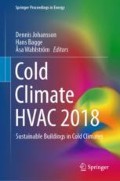Abstract
Net Zero Energy Buildings constitute one measure to reduce energy use and increase use of energy from renewable sources. Hence, it is important share knowledge and experiences from completed projects. This case study show that it is possible to build Net Zero Energy Buildings with existing techniques. However, a common strategy to prevent or limit the build-up of ice and frost in ventilation heat exchangers, Supply fan shut off, were not suitable this project, since it is air tight buildings. After occurring problems in the first winter, ventilation pre-heater were installed to prevent the build-up of ice and frost. Thanks to placement of temperature sensor after the pre-heater, the increased energy use for pre-heater may be expected to be low, roughly 1 kWh/m2a.
Access this chapter
Tax calculation will be finalised at checkout
Purchases are for personal use only
References
International Energy Agency (IEA), SHC Task 40/ECBCS Annex 52 Towards Net-Zero Energy Solar Buildings, 2013 Highlights (2013)
A.C. Menezes, A. Cripps, D. Bouchlaghem, R. Buswell, Predicted vs. actual energy performance of non-domestic buildings: using post-occupancy evaluation data to reduce the performance gap. Appl. Energy 97, 355–364 (2012)
C. Demanuele, T. Tweddell, M. Davies, in Bridging the gap between predicted and actual energy performance in schools, World Renewable Energy Congress XI, Abu Dhabi (2010)
B. Bordass, R. Cohen, J. Field, in Energy Performance of Non-domestic Buildings—Closing the Credibility Gap, International conference on improving energy efficiency in commercial buildings, Frankfurt (2004)
J. Rekstad, M. Meir, E. Murtnes, A. Dursun, A comparison of the energy consumption in two passive houses, one with a solar heating system and one with an air–water heat pump. Energy Build. 96, 149–161 (2015)
D. Majcen, L.C.M. Itard, H. Visscher, Theoretical vs. actual energy consumption of labelled dwellings in the Netherlands: discrepancies and policy implications. Energy Policy 54, 125–136 (2013)
D. Majcen, L. Itard, H. Visscher, Actual and theoretical gas consumption in Dutch dwellings: what causes the differences? Energy Policy 61, 460–471 (2013)
P. de Wilde, The gap between predicted and measured energy performance of buildings: a framework for investigation. Autom. Constr. 41, 40–49 (2014)
G. Branco, B. Lachal, P. Gallinelli, W. Weber, Predicted versus observed heat consumption of a low energy multifamily complex in Switzerland based on long-term experimental data. Energy Build. 36(6), 543–555 (2004)
N. Kampelis, K. Gobakis, V. Vagias, D. Kolokotsa, L. Standardi, D. Isidori, C. Cris-talli, F.M. Montagnino, F. Paredes, P. Muratore, L. Venezia, Μ.K. Dracou, A. Montenon, A. Pyrgou, T. Karlessi, M. Santamouris, in Evaluation of the Performance Gap in Industrial, Residential & Tertiary Near-Zero Energy Buildings, Energy and Buildings
Strusoft, VIP Energy 2.1, www.strusoft.se Visited Sept 10, 2017
ASHRAE, Standard Method of Test for the Evaluation of Building Energy Analysis Computer Programs (ANSI Approved) (2014)
Sveriges Centrum för Nollenergihus, Kravspecifikation för nollenergihus, passivhus och minienergihus (2012)
E.G. Phillips, R.E. Chant, D.R. Fisher, V.C. Bradley, Comparison of Freezing Control Strategies for Residential Air-to-Air Heat Recovery Ventilators (ASHRAE Annual Meeting, Vancouver, 1989)
J. Kragh, J. Rose, S. Svendsen, in Mechanical Ventilation with Heat Recovery in Cold Climates, 7th Symposium on Building Physics in Nordic Countries, Reykjavik (2005)
Alonso M. Justo, P. Liu, H.M. Mathisen, G. Ge, C. Simonson, Review of heat/energy recovery exchangers for use in ZEBs in cold climate countries. Build. Environ. 84, 228–237 (2015)
Author information
Authors and Affiliations
Corresponding author
Editor information
Editors and Affiliations
Rights and permissions
Copyright information
© 2019 Springer Nature Switzerland AG
About this paper
Cite this paper
Berggren, B. (2019). A Net ZEB Case Study—Experiences from Freezing in Ventilation Heat Exchanger and Measured Energy Performance. In: Johansson, D., Bagge, H., Wahlström, Å. (eds) Cold Climate HVAC 2018. CCC 2018. Springer Proceedings in Energy. Springer, Cham. https://doi.org/10.1007/978-3-030-00662-4_51
Download citation
DOI: https://doi.org/10.1007/978-3-030-00662-4_51
Published:
Publisher Name: Springer, Cham
Print ISBN: 978-3-030-00661-7
Online ISBN: 978-3-030-00662-4
eBook Packages: EnergyEnergy (R0)

